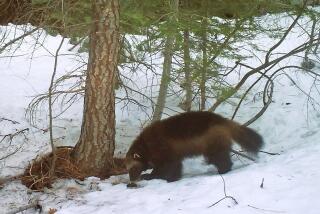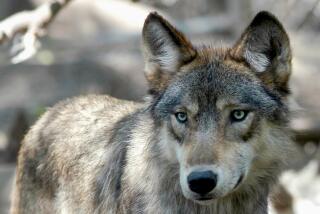On the heels of one rare gray wolf’s epic journey into California, another arrives

A young male gray wolf crossed into far Northern California early this month — joining another wolf that trekked into the state in late January and made an epic journey south.
The latest wolf to arrive in California — called OR-103 — was outfitted with a GPS collar in Deschutes County, Ore. He entered northeastern Siskiyou County on May 4, according to the California Department of Fish and Wildlife.
It’s not clear exactly where OR-103 came from. There isn’t a pack of wolves in the area where he was collared, so it’s believed the roughly 1- to 2-year-old wolf was in the process of dispersing — striking out from his pack in search of new territory and a mate, said Roblyn Brown, wolf program coordinator for the Oregon Department of Fish and Wildlife.
With Oregon’s wolf population expanding, “there will be more wolves dispersing to California,” Brown said. “It just shows that there’s a healthy population growth of the wolves.”
There were at least 173 wolves in Oregon at the end of 2020, a 9.5% increase over the previous year’s tally, according to a state Department of Fish and Wildlife report.
Before 2011, a gray wolf hadn’t been spotted in California since the 1920s, when the native apex predators were wiped out by hunters. Over the last decade, there’s been a small but gradual increase in wolves coming in from out of state, exciting wildlife conservationists but alarming ranchers who fear for the safety of their livestock.
California lists the wolves as endangered, but they were removed from the federal roster in January by the Trump administration.
With just a few handful of wolves in California, conservationists see every new arrival as a potential boon to the species’ survival in one of its historic territories.
Oregon wildlife officials collected DNA from OR-103 and sent it to a lab for analysis. But there’s no certainty the results will be sufficient to trace his origins, Brown said.
“Depending on whatever pack he came from, he could be lending new genetics to the California population of wolves,” said Pamela Flick, California program director for Defenders of Wildlife, a conservation organization.
OR-93, the wolf that preceded the most recent arrival, hailed from southeast of Mt. Hood, whereas the majority of wolves in California are from northeastern Oregon. With his arrival came the promise of much-needed genetic diversity, Flick said.
But OR-93’s GPS collar stopped transmitting a signal in early April. Before the signal went dark, he was tracked in San Luis Obispo County — marking the first time in more than a century that a wolf was hanging out on California’s Central Coast.
It’s unknown if the lost signal is due to a technical issue, such as a dead battery or him being out of satellite detection range — or if he has met an unfortunate fate, said Flick, who added that she became concerned for his well-being as he traveled farther away from where other wolves have lived in contemporary times.
And his chances of meeting a mate so far afield are close to zero.
“I don’t think that there’s a mate out there for him, and it was always my hope, as he was heading that direction, that he would turn around and head back to Northern California,” said Amaroq Weiss, senior West Coast wolf advocate for the Center for Biological Diversity, “because that’s where it’s more likely that he will run into a lone wolf.”
Even if he doesn’t become a patriarch, Flick sees his trailblazing as significant. Wolves tend to follow in the “paw steps” of others that came before them, often drawing on their sharp sense of smell, meaning OR-93 could lead others to the area, she said.
Traversing hundreds of miles, OR-93 crossed several treacherous freeways and risked encountering ranchers wary of wolves preying on their livestock.
“The thought in every rancher’s mind, in the territory that a wolf is coming through, is ‘I hope they don’t attack my herd,’” said Kirk Wilbur, vice president of government affairs for the California Cattlemen’s Assn. “So there’s always that concern in the back of a rancher’s mind, about the loss of cattle or the injury of cattle from a wolf.”
With so few wolves in California, the threat wolves pose to livestock isn’t widespread. Instead, it’s individual operations that tend to suffer disproportionate losses, according to Wilbur and Flick.
The losses “can be really emotionally devastating to a rancher,” Wilbur said. “It’s devastating to them both financially and emotionally.”
More to Read
Start your day right
Sign up for Essential California for news, features and recommendations from the L.A. Times and beyond in your inbox six days a week.
You may occasionally receive promotional content from the Los Angeles Times.







